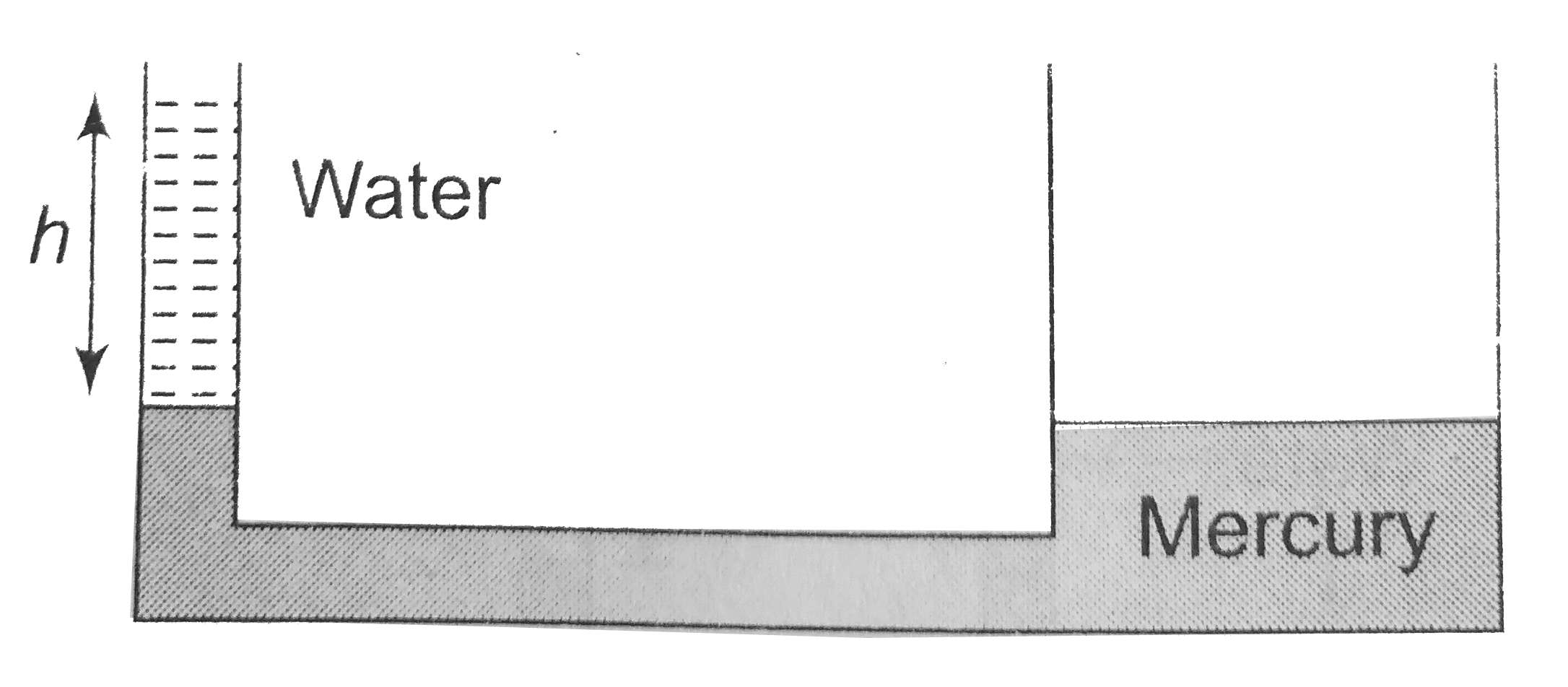in previous question, if 15 cm of water and spirit each are further poured into the respective arms of the tube. Difference in the level of mercury in the two arms is (Take, relvative density of mercury = 13.6)
On pouring 15.0 cm of water and spirit each into the respective arms of the U tube, the mercury level will rise in the arm containing spirit. Let h ve the difference in the levels of mercury in two arms of U tube and ρ be the density of mercury.
∴ The pressure exerted by h cm of mecury column = difference in pressure exerted by water and spirit
∴hρg=h1ρ1g−h2ρ2g ...(i)
here, h=?,ρ=13.6cm−3,h1=15+10=25cm,ρ1=1gcm−3
h2=15+12.5=27.5cm,ρ2=0.8gcm−3
Putting values in (i), we get
h×13.6×g=25×1×g−27.5×0.8×g=3gorh=3/3.16=0.22cm.
Topper's Solved these Questions
- BOOK - PRADEEPCHAPTER - PROPERTIES OF BULK MATTEREXERCISE - Higher Order thinking skells17videos
PROPERTIES OF BULK MATTER
- BOOK - PRADEEPCHAPTER - PROPERTIES OF BULK MATTEREXERCISE - Value Based Question5videos
PROPERTIES OF BULK MATTER
- BOOK - PRADEEPCHAPTER - PROPERTIES OF BULK MATTEREXERCISE - Advanced problems for competitions21videos
PROPERTIES OF BULK MATTER
- BOOK - PRADEEPCHAPTER - PHYSICAL WORLD AND MEASUREMENTEXERCISE - Competiton Focus Jee Medical Entrance18videos
PHYSICAL WORLD AND MEASUREMENT
- BOOK - PRADEEPCHAPTER - RAY OPTICSEXERCISE - Problem For Practice(a)25videos
RAY OPTICS
Similar Questions
Knowledge Check
- Question 1 - Select One
An open U-tube contains mercury. When 11.2 cm of water is poured into one of the arms of the tube, how high does the mercury rise in the other arm from its initial level ?
A0.82 cmB1.35 cmC0.41 cmD2.32 cm - Question 2 - Select One
Two communicating vessels contain mercury. The diameter of one vessel in n times larger then the diameter of the other. A column of water of height h is poured into the left vessel. The mercury level will rise in the right hand vessel (s = relative density of mercury and ρ = density of water) by
 An2h(n+1)2sBh(n2+1)sCh(n+1)2sDhn2s
An2h(n+1)2sBh(n2+1)sCh(n+1)2sDhn2s
A manometer tube contains mercury of density 13.6×103 kg m−3. What difference in the levels of mercury in the two arms is indicated by a gauge pressure of 1.03×105Pa?
View SolutionThe height of mercury which exerts the same pressure as 20 cm of water column, is
View SolutionA cylinder of iron floats vertically and fully immersed in a vessel containing mercury and water. Find the ratio of the length of the cylinder immersed in water to that immersed in mercury. (Relative density of mercury = 13.6 and that of iron = 7.78)
View SolutionTwo cylindrcal vesels placed on a horizontal table contain water and mercury respectively up to the same height. There is a small hole in the walls of each of the vessels at half the height of liquids in the vessels. Find out the ratio of the velocities of efflux of water and mercury from the holes. Whcih of the two jets of liquid will fall at a greater distance on the table from the vessel? Relative density of mercury with respect to water = 13.6
View SolutionIn a constant volume gas thermometer, the pressure of the working gas is measured by the differenced in the levels of mercury in the two arms of a U-tube connected to the gas at one end. When the bulb is placed at the room temperature 27.00C, the mercury column in the arm open to atmosphere stands 5.00cm above the level of mercury in the other arm. When the bulb is placed in a hot liquid, the difference of mercury levels becomes 45..0Cm. Calculate the temperature of the liquid. (Atmospheric pressure =75.0cm of mercury).
View SolutionA U-shaped tube open to the air at both ends contains some mercury. A quantity of water is carefully poured into the left arm of the U-shaped tube until the vertical height of the water column is 15.0cm.
(a) What is the gauge pressure at the water mercury interface ?
(b) Calculate the vertical distance h from the top of the mercury in the right hand arm of the tube to the top of the water in the left-hand arm.
 .View Solution
.View Solution

